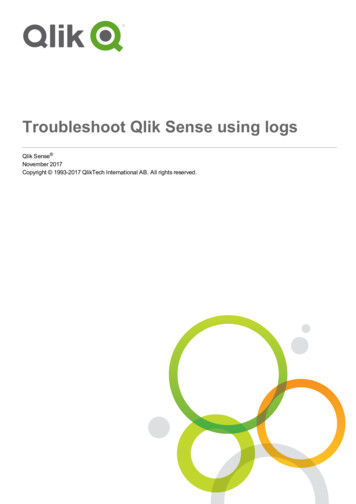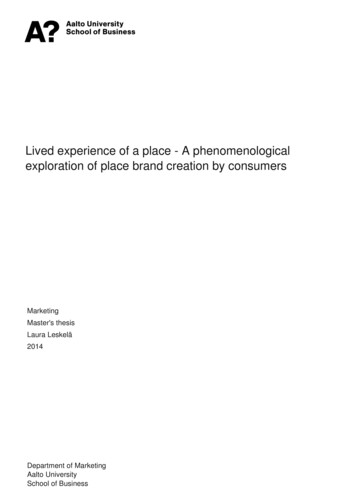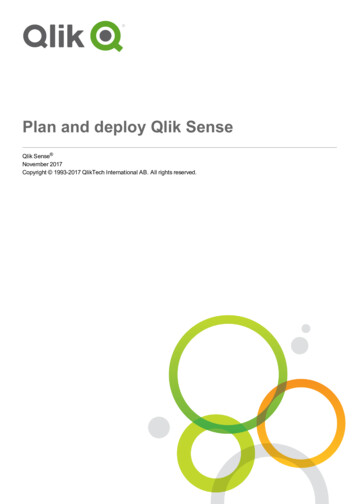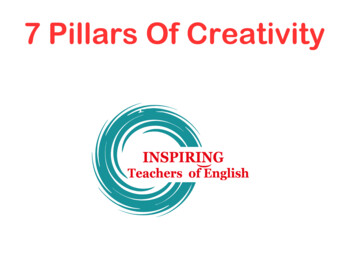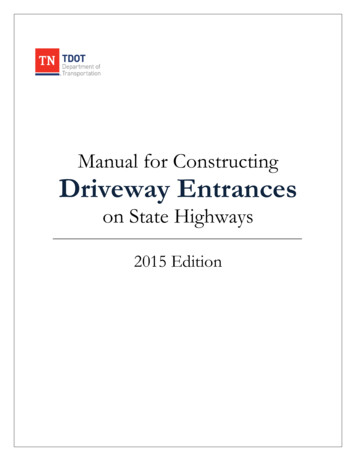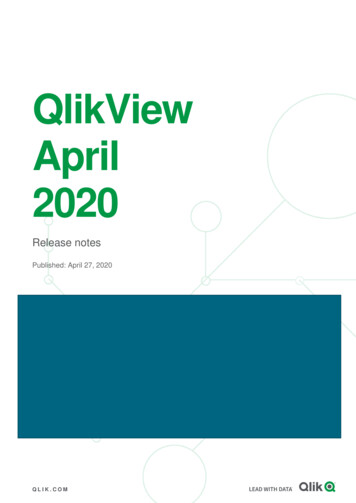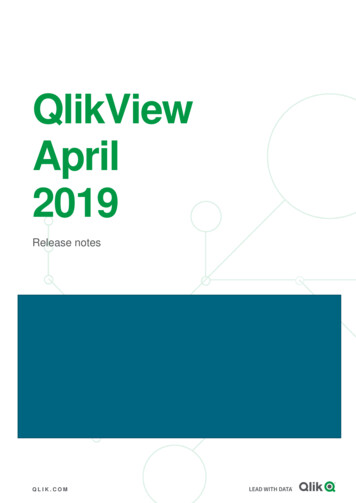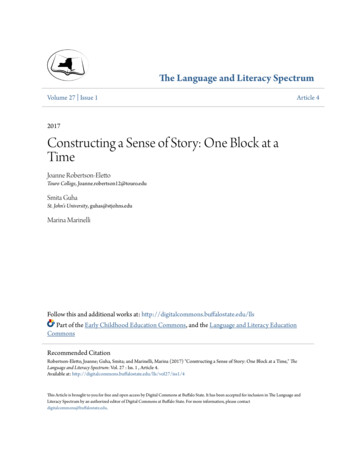
Transcription
The Language and Literacy SpectrumVolume 27 Issue 1Article 42017Constructing a Sense of Story: One Block at aTimeJoanne Robertson-ElettoTouro College, Joanne.robertson12@touro.eduSmita GuhaSt. John's University, guhas@stjohns.eduMarina MarinelliFollow this and additional works at: http://digitalcommons.buffalostate.edu/llsPart of the Early Childhood Education Commons, and the Language and Literacy EducationCommonsRecommended CitationRobertson-Eletto, Joanne; Guha, Smita; and Marinelli, Marina (2017) "Constructing a Sense of Story: One Block at a Time," TheLanguage and Literacy Spectrum: Vol. 27 : Iss. 1 , Article 4.Available at: ss1/4This Article is brought to you for free and open access by Digital Commons at Buffalo State. It has been accepted for inclusion in The Language andLiteracy Spectrum by an authorized editor of Digital Commons at Buffalo State. For more information, please contactdigitalcommons@buffalostate.edu.
CONSTRUCTING A SENSE OF STORY2IntroductionYoung children enjoy sorting, arranging, and building with blocks, and naturally gravitatetowards play with them. Through construction and deconstruction, they develop fine and grossmotor skills (Ferrara, et. al. 2011), perceptual and cognitive awareness (Cristenson & James,2015), as well as visual/spatial concepts necessary for exhibiting the power of literacy andnumeracy. Early learners also practice abstract thinking through block play, demonstrate theirknowledge of systems and structures, and build foundations for mathematical thinking throughexploration with blocks (Piccolo & Test, 2010). Preschoolers symbolically represent their ideas
CONSTRUCTING A SENSE OF STORY3by manipulating and arranging blocks, permitting educators to view their evolving “theories ofthe world” (Smith, 1975). Wynn and Harris (2013) assert that a thoughtfully planned andstocked preschool block center can support planned intentional learning experiences, specificallyin the area of engineering. Christenson and James (2015) have demonstrated how preschoolblock play can be integrated with STEM instruction to promote authentic learning.In high-quality preschools and kindergartens academic learning is playful, and at thesame time exploratory. Exemplary primary teachers weave in academic goals and objectives asthey build on what children can do, while challenging them to try new things (Grolund, 2001).Oral language development and literacy learning are supported through the integration of blockplay. Snow, Eslami, Park, & Young (2015) explored the writing behaviors of kindergartenchildren. They established that literacy-enriched block centers can benefit early childhoodclassrooms serving culturally, linguistically, and socioeconomically diverse students.Wellhousen & Giles (2005) explain the ways block play provides the context for reading andwriting with a purpose, along with an excellent opportunity to integrate literature to enhancechildren’s literacy development. They describe the ways block play fosters visualdiscrimination, use of abstract symbols and oral language development necessary for learning toread and write.A Delicate Balancing ActHowever, contrary to this research, academic versus play-based models of learningcontinue to dominate the early childhood landscape. Increased attention from policy makers,stakeholders, and even parents, have caused primary teachers to reconsider what they believeabout developmentally appropriate practice in the formative years of learning, and its fit with the
CONSTRUCTING A SENSE OF STORY4curricular materials they have been asked to use with their preschoolers. It is a delicate balancingact.The preschool teachers we worked with understand that children’s perceptions as learnersare influenced by the classroom environment. Espousing a “growth mindset” (Dweck, 2006),they realize that their students are in the “process of becoming” (Owocki & Goodman, 2002),and enter their classrooms equipped with abundant social, cultural, and cognitive resources.They acknowledge the ways dramatic play enhances oral language development and vocabulary(Roskos & Christie, 2001). They appreciate the fact that their students are eager learners and“meaning makers” (Wells, 2009). That is to say, they strive to create ways to promoteinteractive, meaningful, and integrated learning experiences that meet the needs of the wholechild.The following photo essay describes one such teacher’s comprehensive plan to modifyliteracy instruction, while staying true to her beliefs about developmentally appropriate learningexperiences during the preschool years. She accomplished this by engaging her students in aReggio inspired, long-term “Castle” project that led to greater opportunities for developmentthrough play, conversation, and active exploration in the block, art, reading, and writing centers.As the mentors for this project, we highlight the ways the teacher documented the“visible learning” (Hattie, 2016) she observed through anecdotal records and thephotodocumentation she correlated to state standards. We analyze the relationship betweenpreschooler’s evolving block creations and the complexity of the stories they generated overtime, suggesting a reciprocity of thinking between the construction and storytelling processes.Patterns are identified and connections made between the structure of dictated stories and
CONSTRUCTING A SENSE OF STORY5students’ block play constructions. The seminal research of Arthur Applebee (1978) aboutconcept of story in the early years, is used for analysis and comparison, to determine theunderstandings of 21st century preschoolers. Photographic documentation, teacher’s anecdotalrecords, and transcriptions bring to life the children’s ideas about family and community lifeduring medieval times.The lens through which we analyze the data is theoretically grounded in philosophies ofemergent literacy (Clay, 2000; Owocki & Goodman, 2002); language and cognitive development(Vygotsky, 1978); “developmentally appropriate” teaching practices (Bredekamp, 1987); socialand dialogic contexts of language development (Morrow, 2007; Britton, 1993; & Wells, 2009);cultural and familial understandings preschoolers bring to the classroom (Dyson, 1997); andconceptual understandings necessary for learning to read and write. Preschoolers’ comments andliteracy artifacts are analyzed for concepts of print, vocabulary knowledge, transfer of learningfrom the “Castle Project,” and ability to dictate detailed and cohesive stories. The apprenticeshiprole (Schikendanz & Casberge (2009), and the influence of the “more capable other” (Vygotsky,1978) in learning to write are emphasized.Project BackgroundAs part of a year-long university-school partnership, we were invited to mentor preschoolteachers from an urban, private school district in New York. During the 2012-2013 school year,teachers participated in monthly professional learning sessions that focused upondevelopmentally appropriate teaching practices, assessment of early literacy behaviors, inquirybased approaches, and the use of “provocations” (Edwards, Gandini, & Forman, 1993) orquestions, ideas, theories, or discussion that peak children’s interest and foster engagement in the
CONSTRUCTING A SENSE OF STORY6preschool years. Participants reviewed and drafted checklists and protocols for evaluatingliteracy development from prekindergarten to grade two. They collaborated to interpret andreview preschoolers’ writing development.During seminars, teachers explored ways to develop inquiry projects, to enable childrento share what they already know, and to extend learning experiences through multiple forms ofexpression and symbolic representation. A focus on “I wonder” questions was stressed, as wellas a shared sense of curiosity, so the projects would reflect students’ own interests. In addition,we visited classrooms regularly to model literacy lessons, to enrich learning experiences throughsociodramatic play, to offer resources, and to document the teachers’ and students’ progress.The focus of this photo essay is the work of Ms. Marinelli’s preschool children and their“Castle Project.” The student population was culturally and linguistically diverse: Black (1.9%),White (71.9%), Latino (14.7%), Asian (8.8%), Pacific Island, American Indian/Other (2.6%).Most of the preschoolers spoke more than one language.The “Castle Project” -Phase OneThe preschoolers were excited about the project, perhaps because knights, princesses,dragons, and castles were something familiar from fairy tales and pop culture. In order todetermine children’s shared understandings and to generate inquiry questions, Ms. Marinelliused graphic organizers, art projects, and literature to build schema for concepts and unfamiliarvocabulary. Students helped to generate charts, suggesting things they wanted to know about.Their topics of interest were: food, clothes, games, and parties in medieval times, as well as“parts of a castle,” specifically the kitchen. Ms. Marinelli’s strategy of generating student ideasexemplifies the “provocation” approach to teaching and learning (Edwards, C., Gandini, L. &
CONSTRUCTING A SENSE OF STORY7Forman, G., 1993). That is, using an idea or subject that invites the young child to activelyparticipate in the discussion and decision making. The areas of inquiry the children selectedwere similar to topics that Ms. Marinelli had generated beforehand.Figure 1Throughout the project, Ms. Marinelli actively listened, asked open ended questions toextend her children’s thoughts, modeled rich language by reading aloud daily, used interactiveSmart Board activities to supplement schema, sketched and annotated diagrams of thepreschoolers’ block creations, transcribed their stories to record oral language development, and
CONSTRUCTING A SENSE OF STORY8continually reflected upon her students’ learning. The “Castle Project” emerged as a sharedcombination of teacher and student goals and interests.Children’s early writing samples, as expected, took the form of pictures (Figure 1). Ms.Marinelli meticulously transcribed what they said about their drawings. Through thetranscriptions of their words, the preschoolers were learning that what they say can be writtendown for someone else to read (Clay, 2000). Preschoolers liked comparing and contrasting life inmedieval times to modern day. Ms. Marinelli correlated project goals with the preschoolcurriculum, that is, how each person contributes to the well-being and productivity of his/hercommunity.Preschoolers decided that the contemporary counterpart to a knight would be a policeofficer. For the most part, boys were interested in hunting and weapons, and girls wrote aboutprincesses and cooking. The three- and four-year-olds drew pictures of cooking, and liked theidea of roasting a chicken “using a pole” over a fire. The children asked and generated questions,such as: How do you get food in the castle?Who cooks your food?Who keeps the neighborhood safe?Who puts out a fire?Who delivers a letter?
CONSTRUCTING A SENSE OF STORY9Figure 2Children’s language development was facilitated by their collaborative efforts and therich learning contexts of the inquiry project. We observed preschoolers use a combination ofdrawing, dictating, and speaking to express themselves. They began to refine theirconversational competencies through play and construction. The following problem-solvinginterchange was transcribed during block play depicted in Figure 2. In this interchange, the threeand four-year-olds demonstrate an ability to listen, contribute ideas, extend each other’sthoughts, and pursue a project collaboratively. They had developed sophisticated wordknowledge (“moat, “turret,” “drawbridge” and “foe”) through the “hands-on and minds on”activities of the “Castle Project.”Lorenzo: The castle has to be on a hill so the king can see strangers coming.Sergio: Friend and foe!Jonathan: The turrets are on top.
CONSTRUCTING A SENSE OF STORY10Jose: What about the moat?Sergio: We will need a drawbridge.Lorenzo: We can use paper.Jonathan: No, we need flat bricks so people can walk in here.Jose: And we need the cream to make them strong. [He is referring to mortar from adocumentary they watched on the Smart Board]Sergio: People can walk here to get inside.Jose: (Takes a curved block) This is a fountain.Sergio: (Takes the blocks with holes in the center) These are here for the bows and arrows.Jose: People live here.Lorenzo: No one can get in the castle because there is so much stuff!A visual record of their engineering feats was sketched by Ms. Marinelli on a daily basis(Figure 3). She had taught preschoolers for several years, and was pursuing her Masters in EarlyChildhood. Her first degree was a Bachelors in the Visual Arts. Her ability to sketch the castlestructures with such ease and fluidity, and to design art-inspired literacy tasks was extraordinary.She was passionate about the arts and thoughtful about ways to integrate it with early literacylearning. Through a multimodal approach to instruction, Ms. Marinelli moved her students fromsurface to deep levels of understanding about the processes of building and writing. The childrenenjoyed the personal attention they received during transcription times, and often asked to havesomething written about their work.
CONSTRUCTING A SENSE OF STORY11Figure 3Phase TwoThe Smart Board became a window into children’s work over time. Ms. Marinelliuploaded photographs, and students enjoyed talking about their creations. The Smart Board wasalso a window to the outside world for the preschoolers, as fieldtrips were not possible due toissues related to insurance coverage. Therefore, the three- and four-year olds watched shows andviewed pictures related to Stonehenge, life in medieval times, and even the contemporaryconstruction of a medieval castle in Normandy, France. They enjoyed YouTube videos aboutmaking armor, tournaments, and jousting. One preschooler associated the jousting activities tohis own world stating, “My dad watches horses too at Belmont.” The influences of Black Boardtexts found their way into the preschoolers’ block center conversations as well. When
CONSTRUCTING A SENSE OF STORY12constructing fortifications and structures, they implemented toy tools to imitate the engineersthey watched on the Smart Board chiseling stones for a castle in France.Figure 4Ms. Marinelli read narrative and expository texts to extend her preschoolers’ sense ofstory beyond fairy tales, and to answer the questions they continued to ask as the project evolved.In addition to listening to traditional stories such as The Princess and the Pea, Rapunzel, andSaint George and the Dragon, they sang nursery rhymes such as “The Queen of Hearts,”“Humpty Dumpty,” and “Sing a Song of Sixpence.” They diligently studied the illustrations in
CONSTRUCTING A SENSE OF STORY13Gravett’s (2008) book entitled Inside a Castle. Ms. Marinelli began adding more books to herlibrary to match the children’s enthusiasm for nonfiction texts.The preschooler in Figure 4 emulates the French engineers, as he puts the finishingtouches on the drawbridge for his moat. The student in Figure 5, is using a Smart Board to tellus how he constructed his curved wall. We noted how confident, articulate, and proud he was toshare his construction details. We also perceived how the integration of technology can facilitateoral language development. The Smart Board aided four-year-old Lorenzo to direct my attentionto specific parts of the fortification he could not explain. The Smart Board also enabledpreschoolers to reflect upon their own learning.
CONSTRUCTING A SENSE OF STORY14Figure 5Playing With Passion and Writing With PurposeChildren became eager builders! Three-year-old’s first constructions were linear, and weappreciated how easily they integrated pop culture characters (Thomas the Train) into their castleenactments. Play was cooperative and storytelling revolved around familiar themes. The threeyear-olds in Figure 6, would eventually extend the linear structure below into the nearbybookshelf, creating a their first castle room on the lower level. Concurrently, they generated newquestions for exploration, expressing an interest in musical instruments and farming in theMiddle Ages.
CONSTRUCTING A SENSE OF STORY15Figure 6Preliminary stories were straightforward as well. Three-year-old Kelsie’s writing sample(Figure 7), demonstrates typical emergent literacy behaviors. Everything she knows aboutwriting is evidenced in the marks she makes upon her page.
CONSTRUCTING A SENSE OF STORY16Figure 7There is an illustration, recurring straight marks, wavy lines (perhaps mimicking cursivewriting), and some conventionally written letters (A, H, and I). It is clear that she has beenobserving the form and function of print in her environment. She uses all that she knows tocreate her story with a title and ending. She dictates the following to Ms. Marinelli:The PrincessOnce upon a time the daddy of a princess was fighting witha dragon. The dragon died with a sword.The EndKelsie reveals a basic understanding of story in her simple narrative. There is a genre, asevidenced by “once upon a time,” indicating that it is a fairy tale. Even though the title says
CONSTRUCTING A SENSE OF STORY17“The Princess,” the protagonist of the tale appears to be “daddy.” The antagonist is a “dragon.”The problem is resolved in a sword fight. Kelsie provides closure by dictating “The End.” Thestory is cohesive in the fact that the actions work together towards resolution. Applebee (1978)asserts that children’s early narrative forms progress from basic to more complex. He describes“unfocused and focused chains” (gathering or ordering) and “centering narratives” (linking andenriching with character, setting, and theme) story structures. Using Applebee’s (1978) sixstages of development in learning to communicate through story, Kelsie’s story is an early“focused chain.” She has begun to combine two aspects of a story, and to create a preliminarysequence of events. Applebee (1978) proposes that children from ages 2 to 5 possess this storyschema.
CONSTRUCTING A SENSE OF STORY18Figure 8Four-year-old Sergio, exemplifies similar concepts of print in Figure 8. His wavy lines,illustration, and letters A, V, and embellished O with a curlicue, represent his knowledge aboutwriting. He dictates this to Ms. Marinelli:The Story BookOnce there was a dragon. There were two bad guys. They were fighting too.The dragon spit fire on the knights. The knights did nothing. They still get up.Then the dragon went away and didn’t come back.The End
CONSTRUCTING A SENSE OF STORY19A beginning and ending are clearly present in Sergio’s story, as well as protagonists (theknights) and an antagonist (fire spitting dragon). The story has happened a while back, as hebegins with “once,” a past tense. It is definitely an action story with a rudimentary plot. UsingApplebee’s (1978) categorization scale this as an “unfocused chain.” That is, the child hasjoined story elements to produce a narrative with undeveloped events leading from one another.Sergio’s initial stories were a wonderful frame of reference when analyzing the collaborativestories the children drafted a couple of months later. Collecting authentic data within anauthentic context, at different points in time, enabled me to obtain a multilayered overview oforal storytelling during the “Castle Project.”As children’s knowledge about castles increased through exposure to multimodal textsand socialization in the block center, their structures began to move upwards. Over the course ofthree months, heaps of blocks replaced flat rows, and a sense of organization appeared as well.In Figure 9, we see fortified walls, as well as sentries on the watch towers. Later, preschoolerswould add layers of flooring, throne rooms, and entry and exit points and hiding places to theircastles. They were intrigued with chandeliers, and they became a prominent feature in many.
CONSTRUCTING A SENSE OF STORY20Figure 9Dictated stories were also becoming organized with added details. Sergio told a storyevery day, and gained great status in his preschool community as an “author.” He dictated thefollowing:The Knight and the DragonOnce a knight was fighting a dragon that was spitting fire all over the place!The knight had somehing to protect himself. It was a shield.The knight saved all the people in the castle. The knight wasshooting bows and arrows and made the dragon go away.The EndFour-year-old Sergio is well on his way to becoming a proficient writer, and is learninghow to arrange story elements and content to create an exciting tale. Just imagine how delightedhe will be when he learns about pronouns! This story has all the basic elements and begins to
CONSTRUCTING A SENSE OF STORY21surpass the criteria outlined by Applebee. We especially appreciated the students’ articulation ofa perfect title for their stories. For, children’s stories were thematically related to the CastleProject and influenced by the social contexts of their learning.Phase ThreeSergio’s literacy development continued to grow over three months. Initially describedas a reluctant and disinterested learner, he became a leader in many project activities. Hisclassmates enjoyed playing in the story worlds he created, especially the three-year-olds. Projectwork enabled Sergio to capitalize upon his strengths, and to read and write for his own purposes.The same was true for Ms. Marinelli, whose arts background, was a perfect fit for a Reggioinspired approach. She was able to capitalize upon her artistic talents and knowledge base toenrich literacy instruction for all of her students.The boys in Figure 10, led by Sergio, created maps to specify their castle location on ahill. They rolled them up to look like the scrolls they had seen. A paper towel roll became theirtelescope, and a fire helmet became a head armour, exemplifying the transformative thinking ofthe young child.
CONSTRUCTING A SENSE OF STORY22Figure 10Ms. Marinelli continued to promote children’s symbolic representation through the arts,using their artifacts to assess literacy growth. Preschoolers enjoyed creating and talking aboutthe symbols for their shields. Lady Natalia and Lady Jada in Figure 11, used bright and sunnycolors and symbols. As in the dictated stories they generated, there were differences in boys’and girls’ shields. However, in the dramatic center, most children enjoyed dressing up as kings,queens, princesses, and knights, and sitting on a throne. No one dressed as a servant! Theirenactments during sociodramatic play, would later surface in their oral storytelling.
CONSTRUCTING A SENSE OF STORY23Figure 11Figure 12
CONSTRUCTING A SENSE OF STORY24Sharply defined perimeters began to emerge in their fortifications for their livestock andfigurines of people (Figure 12). Children’s experimentation with design, stability, and balanceled to visually impressive structures. More defined structures were complemented by moredefined stories, including multiple characters, more interaction between them, and insertions ofdialogue to move the plot along.Figure 13The addition of a round table to the block center led to the structure in Figure 13. Ms.Marinelli labeled it a “shutter” effect, and we agreed that it had Stonehenge-like features. Blockswere carefully chosen by the preschoolers to create this edifice, and I noted their selection of justthe right word to express emotions during play scenarios. For example, “foe” was one of theirfavorites, a synonym for “bad guy.” Inventive stories were told within this concentric circle, aschildren adopted different personas through the manipulation of figurines and blocks.
CONSTRUCTING A SENSE OF STORY25Concurrently, three- and four-year-olds collaboratively dictated stories to Ms. Marinelli,which they were proud to show me when I visited. These stories were made into board gamesthey enjoyed playing (Figure 14), since they were drawn from their own work. As we reviewedtheir games and writing samples, we were reminded of a quote by Britton (1970), that “writingflows on a sea of talk,” building the foundation for literacy development, and supporting identitydevelopment, including gender perceptions.Figure 14Three-year-old girls collaboratively dictated a version of a familiar tale. The text is intwo fonts to honor both their voices:The Knight and CinderellaOnce upon a time there was a knight. He grew up. Then he went on his horse. Hewas going to a different castle. He crossed a river. He went over a bridge. He saw aghost! It was Casper! He was friendly. Then he saw Cinderella. She was sleeping.
CONSTRUCTING A SENSE OF STORY26She wanted to get away from the ball because it was night. She lost her shoe. Theknight took Cinderella to the castle. He married her.The EndUsing Applebee’s Stages of Schema, their collaborative stories represented a “focused” chain.There are multiple characters, events following upon each other, a conflict and resolution, and thetraditional happy ending. The girl’s story is basically a rescue story with a passive princess, and a takecharge knight. Applebee did not study gender differences in his seminal study, though we noted someapparent differences.Next, a four-year-old boy and a girl collaborated to generate this story. The girl’s voice isitalicized.The Story of the FoodOnce upon a time there was a princess and a knight. They lived in an old castle.They have to go to the forest to get food because nobody would go. There are scaryanimals in the forest. They were riding on their horses. They saw a wolf! They ranvery fast with their horses, but the wolf almost got them. The knight protected theprincess. He was shooting bows and arrows at the wolf. The wolf ran away. Then theysaw some shiny red apples. Someone owned the trees. The man said no one couldeat the apples. Someone had to defeat him first. The knight began to fight. Theknight won! They got the apples. They picked all the fruits and vegetables theywanted. They brought back a lot of food to their castle. The servants cooked it. Theking and queen were happy.The EndWhat a creative tale these four-year-olds create, packed with details and an evolving plot. Thereare two antagonists in the story. First the wolf, who they escape by a wild horse chase. Then, the ownerof the apple orchard who challenges the knight to a sword fight. In both instances the knight protects theprincess, who picks fruits and vegetables to bring to the castle servants to prepare. The preschoolers hadbeen studying community life, specifically farming and agriculture, so they have included this newknowledge into their story. They are very much influenced by the literature and multimodal texts theywere exposed to. The boy creates an action-packed narrative. The girl cushions and softens the story tocreate resolution of the conflict.
CONSTRUCTING A SENSE OF STORY27Lastly, three four-year-old boys write this story, presented in three fonts to represent individualcontributions.The King’s Forest AdventureOnce upon a time there was a king. He was riding on a horse in the forest. He didn’twear his armor. He saw a unicorn gallop up on front of him. Theunicorn was a queen unicorn.He bowed and said, “Your highness” to the unicorn.Then she ran and told an animal friend she had met a king.Then the king saw an owl. He [the king] went [climbed] on his back and began tofly around.He said, “Weee!”He saw a baby whale. When the animal owl flew down the king saw a house and akitchen. The king saw a cow. The king went on the cow. The cow took him to thewoods. Then she took him back to the castle. The king saw the horse come back to thecastle.The EndThe boys have created a circular tale that starts in the forest and ends in the woods. Thefour-year-olds exhibit many strengths as storytellers, not outlined in Applebee’s (1978)“narrative” stage. The concept of story he attributed to five- to seven-year-olds was present in thestories of the preschoolers. We observed that four-years-olds can:o Write with purposeo Incorporate themes from the “Castle Project”o Choose interesting and varied topicso Use word choice and new content vocabularyo Sequences eventso Use dialogueo Use personal voiceo Insert elements that add to the whole storyo Are creative
CONSTRUCTING A SENSE OF STORY28At first, the castle corner was dominated by boys. However, as the project progressedgirls were building castles on a daily basis (Figure 15). Of particular note in this analysis wasthe oral language development of one newcomer student, who was very reticent to speak whenshe came into the preschool classroom. Ms. Marinelli wasn’t sure how much she actuallyunderstood, or if she was just in the quiet period of transition to an English speakingenvironment. At the end of the three months she was sharing stories with her classmates.Figure 15Many of the preschoolers’ parents were thrilled about the sophisticated vocabulary theirchildren were sharing about the project at home. At the end of the three months, Ms. Marinelliinvited them to school to view the documentation and to celebrate their children’saccomplishments. The medieval feast included grape juice, cookies, and snacks!
CONSTRUCTING A SENSE OF STORY29“Pillars of Knowledge”The foundational skills that produce motivated, and confident literacy learners in thepreschool years have been documented in educational research. However, contemporaryapproaches to teaching and learning in the formative years have privileged one set of strategiesover developmentally appropriate approaches. Therefore, robust discussions of alternative,research-based ways of meeting the needs of the young child must begin again to ensure that thisgeneration of learners remain enthusiastic about learning to read and write. A multidi
St. John's University, guhas@stjohns.edu Marina Marinelli . Wellhousen & Giles (2005) explain the ways block play provides the context for reading and writing with a purpose, along with an excellent opportunity to integrate literature to enhance . The preschool teachers we worke

